What is Institutional Casework
Institutional casework can seem hard to define. It’s not commercial cabinetry, nor is it residential. Institutional is it’s own category, but it shares similarities with commercial casework that can make it hard to distinguish.
There are some properties applicable to institutional casework which set it apart from other categories. To begin with, institutional casework is designed for longevity, durability, safety and functionality. These qualities are required in public spaces or applications involving non-owner groups or multiple shifts. Basically, people who don’t own the casework are going to be using it and it’s going to take a lot of abuse, but needs to survive for decades.
Institutional casework must be durable. This means it is engineered (both components and the finished product as a whole) and then independently tested to perform uniformly for an extended life cycle. It also must be safe because the public will be using it.
Institutional casework appears in healthcare, public schools, higher-ed facilities, municipal buildings, research laboratories and emergency and first responder facilities.
In addition, institutional casework is often based on modular designs so it can be easily adapted to new environments and uses. It is also built-to-order using a customized feature palette. Institutional casework buyers have much more control over the finished product than other casework applications.
In this guide we will be exploring the different materials used to manufacture institutional casework and how they apply to specific environments and uses.
Materials comparison
| Material | Cost | Commonly Found | Features |
| Wood | $$ | Science classrooms, research facilities | Natural finishes and nostalgic look, chemical durability. |
| Plastic laminate | $ | Educational classrooms, hospital patient rooms, administration offices | Most flexible, easiest to incorporate colors and design elements. |
| Painted steel | $$ | Research labs, testing facilities, concession buildings | High-durability, excellent chemical resistivity, suitable for research environments. |
| Stainless Steel | $$$ | Hospital support rooms; food service, operating rooms; marine applications | Best all-around strength and durability, great in wet locations. |
| Solid surface | $$$$ | Hygenic locations; ORs; MRI; high end decorative spaces | Most hygienic solution for critical infection exposure, highly customizable, modern aesthetic. Structural panels give great design flexibility. |
| Phenolic | $$$ | Chemistry labs; high moisture environments with high abuse | Structural panels give great design flexibility. Extremely durable. |
| Polymer | $$$ | Wet locations exposed to the elements; water testing labs | Impervious to water. Color-through panels make for uniform design. |
Wood
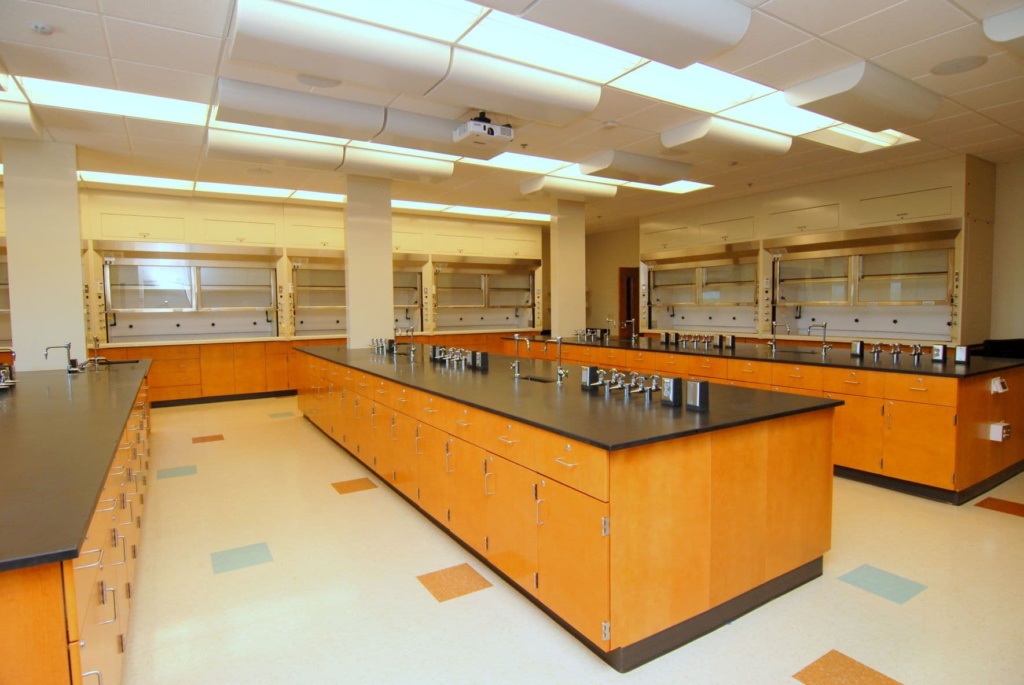
Wood casework brings a warm and natural feel to a space and is commonly used in the laboratory. It’s intrinsic strength and traditional joinery produce cabinetry that is engineered with the scientific process in mind.
One of the advantages this cabinetry brings is the natural beauty of wood, paired with a highly resilient, chemically-resistive finish to increase the cabinet’s longevity and durability. Plus, the structural framing fits the needs of the rigorous laboratory environment. This includes upright chase frames and heavy laboratory equipment that often sits atop the cabinets.
Plastic Laminate
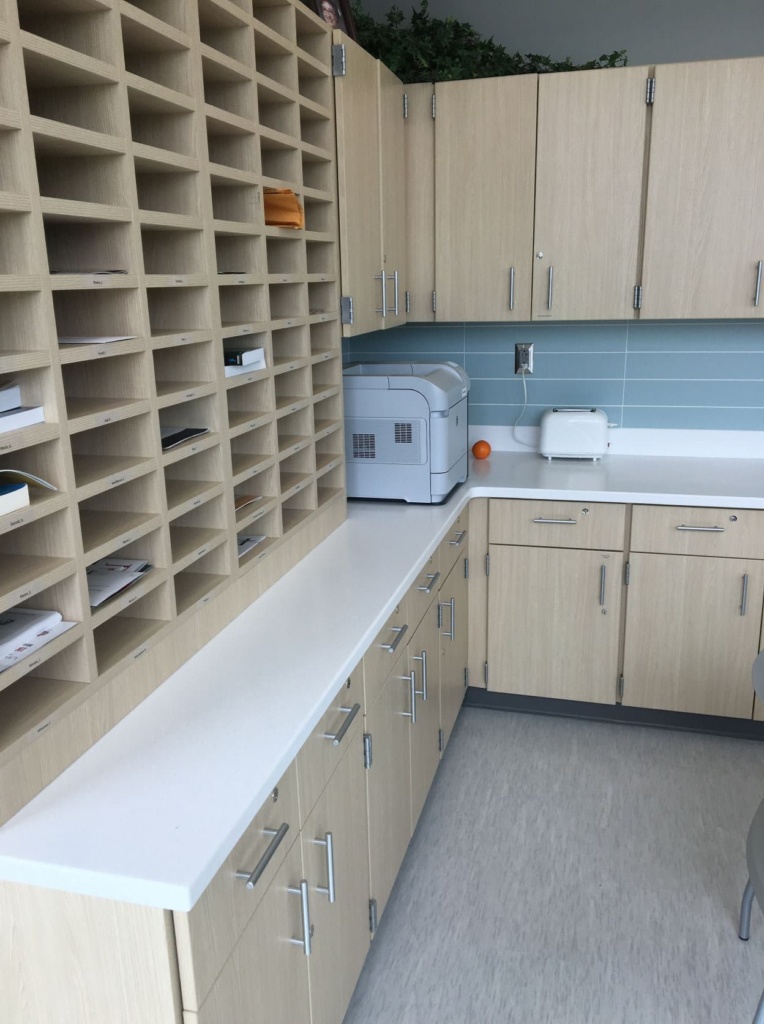
Laminate cabinets are the most versatile type of institutional casework. These cabinets are precision engineered and tested with 50-year durability standards. They can be customized to the millimeter and lend themselves to all market segments: education, business, healthcare, research and municipal. It is best to work with a knowledgeable dealer when planning installations.
Plastic laminate is based on a concept that employs consistent, high-volume manufacturing and is also one of the best ways to introduce sustainability into a project.
The modern laminate cabinet uses a composition particleboard core that is made of reclaimed wood or products that would not otherwise be featured in furniture production. Incorporating this kind of cabinet reduces the consumption of older-growth hardwood products used to make cabinetry in former decades.
Painted Steel
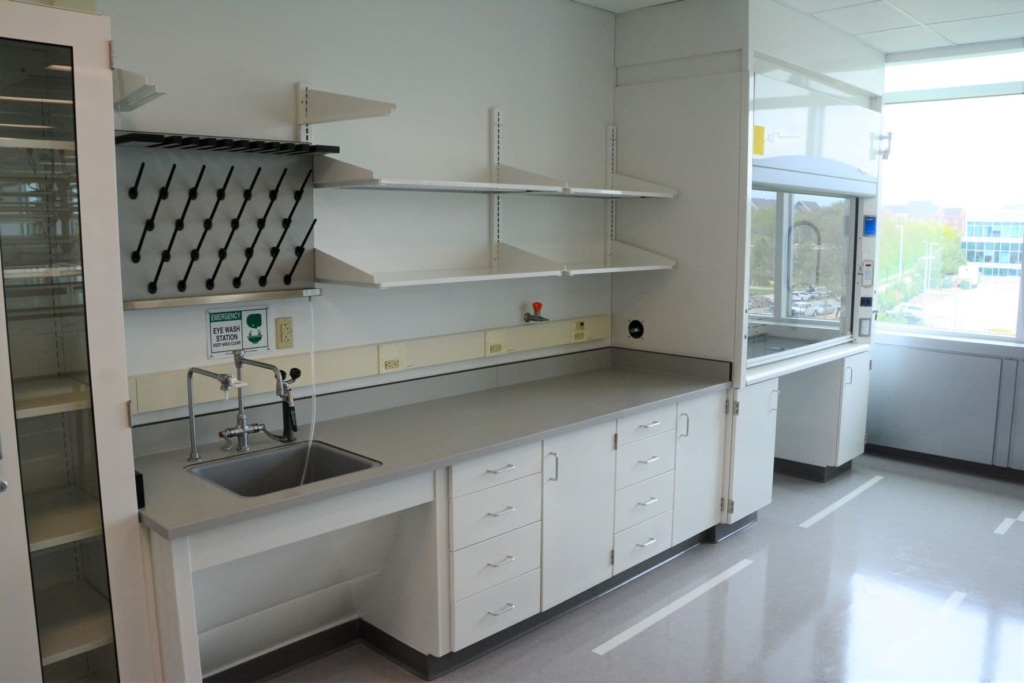
Wet labs, high abuse environments and research facilities demand the durability of steel. With options in advanced epoxy powder coated finishes as well as stainless steel, these cabinets can be trusted to endure over the long haul. In addition, new manufacturing techniques continue to tighten build tolerances and improve the fit and finish of this product.
Many people fear that painted metal is a liability in a wet environment. In reality, painted steel casework is very similar to automobile applications. The powder coated finish seals and protects the cabinet structure from damage or corrosion and can stand up to the spills and exposures of this work.
The welded frames of the cabinetry bodies handle the heaviest weight loads and are well-suited to laboratory applications. Painted steel allow you to bring structurally sound cabinetry into your sensitive healthcare or laboratory environment without risking mold or bacterial growth, which can potentially be a risk with wood-based casework.
Steel cabinets do not lend themselves to the kind of flexibility and customization found with other products in this guide. Sticking with standard configurations and catalogued sizes will help ensure consistency, reduce lead times and keep costs in check.
Stainless Steel
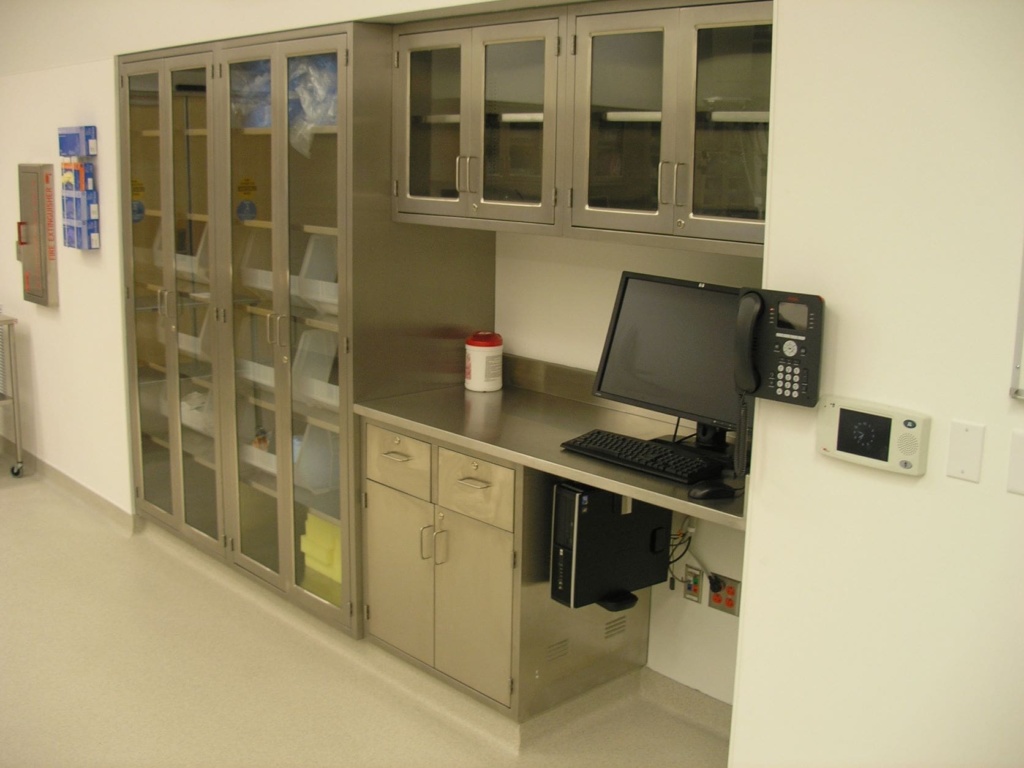
While not always the case, our rule of thumb is that stainless steel cabinets are double the cost of painted steel. That being said, in harsh environments, there’s no material to compare with the durability of stainless steel cabinetry.
In high-abuse areas, stainless steel does not have a painted surface to scratch and introduce rust or corrosion. In wet environments, stainless can be left unattended without adversely affecting it’s performance, even over decades of misuse.
Stainless steel is not typically used in lab settings because exposure to certain chemicals can affect the finish. It is very common in hospital settings however, especially in decontamination or soiled-utility wash stations. It is the ideal product for these areas because it can handle the over-spray and wash-down of cleaning agents without problems.
We also see stainless in laboratory “clean rooms” where any kind of contaminant cannot be tolerated. In educational settings stainless is often used in unattended and non-climate controlled concession buildings. Stainless steel can handle the abuse of multiple unaffiliated user-groups, the exposure to the elements, and will not swell or warp due to changing seasons and lack of climate control.
Solid Surface
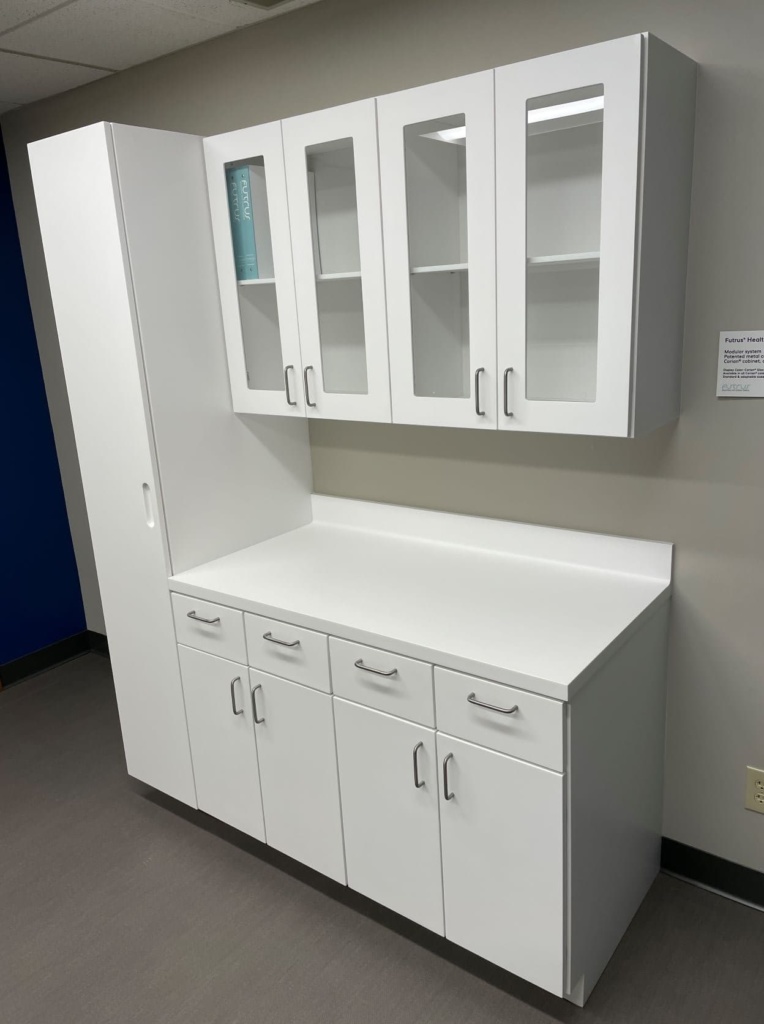
This is one of the most exciting areas of development for the institutional case-work industry. The use of fully solid surface cabinets has been an appealing concept, but until recently was fraught with too many compromises to be commercially viable.
But now, with the advent of the Futrus® patented construction system, the durability and superior infection-control features of solid-surface can be brought to the complete casework assembly, not just the countertops. The ability to bond this type of durable, acrylic sheet to a structural frame overcomes the limitations previously seen with solid-surface that created cracking at seams and a short life-span for the early generation attempts at making cabinetry out of this material.
This product is ideal for areas where infection-control is paramount and resistance to microbial growth is important. Areas like operating rooms, MRI suites, decontamination rooms and cancer centers can all be well-served by this bleach-cleanable system.
Phenolic Resin

These can be expensive cabinets, but they fill a unique position in the market. Because they incorporate a structural panel that is both durable and resistant to chemicals adn moisture, they can be used in settings where other cabinets could fail structurally or deteriorate due to corrosion.
The phenolic cabinet was initially developed to address the locker-room area in schools and gyms. Phenolic resin offered a solution for cabinets that were exposed to moisture, scratching and denting by making the entire cabinet, body and doors, out of a durable, water-resistant, machinable panel.
The incorporation of the chemical resistant surface—so beneficial in laboratory countertops—has been brought into the construction of cabinetry. It creates a durable, corrosion-resistant product that can handle high-moisture environments easily. These cabinets appear in wet areas like natatorium offices and scoring areas. In some laboratory applications, where the environment is both corrosive and high in moisture, phenolic resin shines.
Polymer
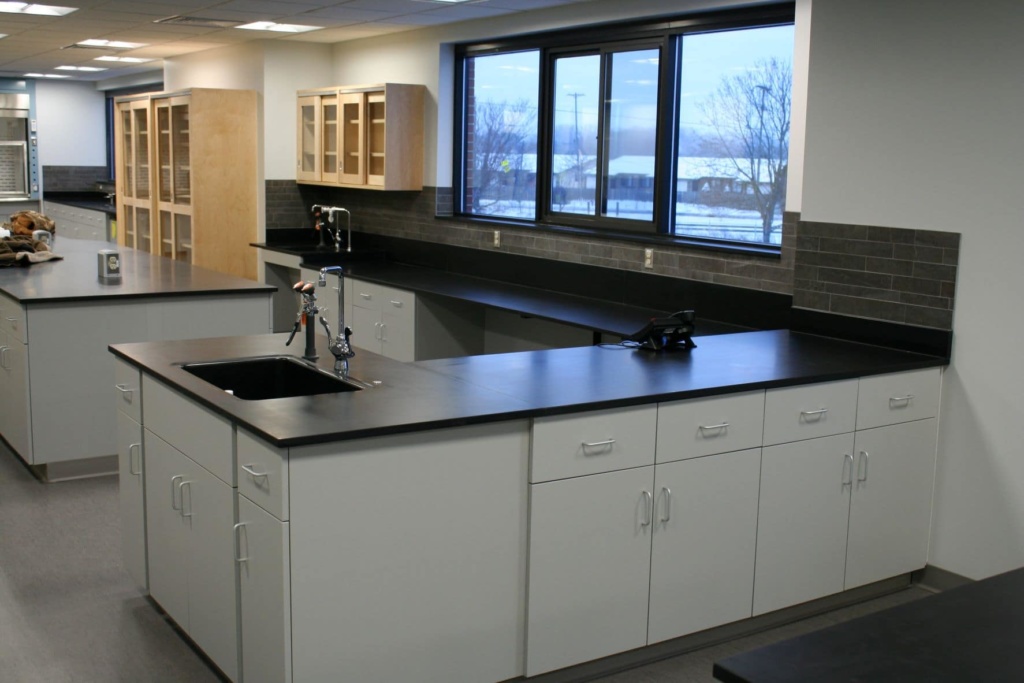
Environments where water is prevalent are a constant threat to most casework with internal cores, such as particle-board. There has been an idea in the casework industry that if all of the internal construction cores susceptible to the ravages of moisture could be eliminated, you might have the ideal casework construction option.
Polymer cabinets come close to this ideal design by working with a homogenous sheet of waterproof and stain-resistant polymers. These sheets of plastic have great resilience, so they don’t chip or crack and they are perfect for high-moisture environments.
Wastewater treatment plants, where the testing labs are constantly exposed to water samples and where chemicals are used for analysis in every process, are a great place to introduce this unique solution.
Environments like pools, marine and aquatic research facilities, procedure rooms and service locations in zoos find an ideal solution in polymer casework. These cabinets are easy to machine, have UV stable components, so they can survive inside or outside, and handle most any kind of harsh environment.
Choosing Materials For Institutional Casework
The right choice of material is based on a number of factors. The environment, user groups, use of the casework and budget all work together to determine the right material for the job. It’s best when weighing institutional casework materials to consult knowledgeable advisors to help you make the most informed and effective decision.
When unsuitable materials are used in institutional environments, the consequences are public and can be severe. Forethought and planning today can save money and time and protect your reputation down the road.